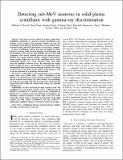Detecting sub-MeV neutrons in solid plastic scintillator with gamma-ray discrimination
Author(s)
Kovash, Michael A.; Daub, Brian; French, Jennifer Erin; Hanzl, Vladimir; Shoniyozov, Khayrullo; Matthews, June L.; Miller, Zachary; Yang, Hongwei; ... Show more Show less
Downloadmatthews paper with ghent.pdf (382.4Kb)
OPEN_ACCESS_POLICY
Open Access Policy
Creative Commons Attribution-Noncommercial-Share Alike
Terms of use
Metadata
Show full item recordAbstract
We report on recent efforts to design a solid plastic scintillation hodoscope to measure neutron production cross sections at low energies. Our program includes not only the development of the detector itself, but also a set of auxiliary measurements which will help characterize its low-energy response. A novel scintillation counter has been developed to detect sub-MeV neutrons while rejecting gamma-ray backgrounds with good efficiency. The detector uses multiple layers of thin solid scintillator, with optical isolation between the adjacent layers. Incident low-energy neutrons produce ionizing recoil particles which remain within just one of the scintillator layers, while background gamma rays create electrons which most often cross the boundary between layers. By observing the trigger pattern within the layers, most gamma-ray backgrounds can be distinguished from the low-energy neutrons of interest. We report on the results of our Monte Carlo studies of this design, as well as on the operation of a prototype detector unit. We also have undertaken a new measurement of the neutron-proton total cross section below 1 MeV. Calculations of the efficiency for detecting low energy neutrons in plastic scintillator rely on accurate low energy n-p cross sections, yet surprisingly few such data currently exist. New measurements which span the region from 150 to 800 keV neutron (lab) energy are reported and discussed. Additionally, we have measured the light response of BC 418 scintillator for recoil proton energies as low as 100 keV. Recoil protons are produced at a known energy in the scintillator by placing it in a neutron beam and detecting in coincidence the elastically scattered neutrons at fixed angle. Our new results extend the energy range of previous measurements of the light response of solid organic scintillators, and may indicate a significantly modified response at the lowest observed energies.
Date issued
2011-06Department
Massachusetts Institute of Technology. Department of PhysicsJournal
2011 2nd International Conference on Advancements in Nuclear Instrumentation, Measurement Methods and their Applications (ANIMMA)
Publisher
Institute of Electrical and Electronics Engineers
Citation
Kovash, Michael A., Brian Daub, Jennifer French, Vladimir Henzl, Khayrullo Shoniyozov, June L. Matthews, Zachary Miller, and Hongwei Yang. Detecting sub-MeV Neutrons in Solid Plastic Scintillator with Gamma-ray Discrimination. In 2011 2nd International Conference on Advancements in Nuclear Instrumentation, Measurement Methods and Their Applications, 1-3. Institute of Electrical and Electronics Engineers, 2011.
Version: Author's final manuscript
Other identifiers
INSPEC Accession Number: 12639747
ISBN
978-1-4577-0927-2
978-1-4577-0925-8
978-1-4577-0926-5
1457709252